Respiratory Rate Assessment Tool
Assess Breathing Rate
Count how many breaths you or someone else takes in 30 seconds. Then enter the number below.
Normal breathing rate: 12-20 breaths per minute
Warning sign: Breathing rate below 12 breaths per minute is dangerous with opioids
Results
When someone takes an opioid - whether it’s prescription painkillers like oxycodone, or illicit drugs like heroin or fentanyl - their breathing can slow down. Not just a little. Sometimes, it stops. This isn’t a rare side effect. It’s the leading cause of death in opioid overdoses. In 2022, over 107,000 people in the U.S. died from drug overdoses, and 82% of those involved opioids. Most of those deaths weren’t from heart failure or organ damage. They were from breathing that simply didn’t happen anymore.
How Opioids Kill by Stopping Breathing
Opioids don’t just make you sleepy. They hijack the brain’s breathing control center. For years, doctors thought opioids depressed breathing by calming the whole brainstem. But new research shows it’s far more precise - and dangerous.
Two key areas in the brainstem are targeted: the preBötzinger Complex and the lateral parabrachial nucleus. The preBötzinger Complex is the rhythm generator - it tells your lungs when to inhale. Opioids make these neurons fire less. In lab studies, opioid exposure cuts their activity by more than 60%. But that alone doesn’t explain why breathing stops completely.
The real killer is the lateral parabrachial nucleus. This region controls the timing between breaths - especially the pause after you exhale. When opioids bind to receptors here, that pause gets longer. In rats, morphine increased expiratory time from less than a second to over two seconds. That’s not just slow breathing. That’s the space between breaths becoming a gap too wide to recover from.
At the cellular level, opioids open potassium channels that hyperpolarize neurons - basically, they make them too tired to fire. Add to that a 40% drop in how well those neurons talk to each other, and you’ve got a system that’s not just slowed down - it’s disconnected. This is why naloxone, the standard overdose reversal drug, sometimes fails. It can block the opioid from the receptor, but if the neurons are too damaged or the synaptic connections are broken, breathing doesn’t snap back.
Why Fentanyl Is So Much More Dangerous
Not all opioids are the same. Morphine takes 20 minutes to hit its peak respiratory effect. Fentanyl? Five minutes. Carfentanil? Less than two. And potency matters. Fentanyl is 50 to 100 times stronger than morphine. Carfentanil - used to tranquilize elephants - is 10,000 times stronger.
This means a tiny amount can trigger full respiratory arrest before anyone even realizes something’s wrong. Emergency responders now report cases where people collapse with no warning, and even 2 mg of naloxone - the standard dose - isn’t enough. Some patients need 10 mg or more. But most naloxone auto-injectors only deliver 2 mg. That’s a deadly gap.
Also, synthetic opioids like fentanyl stick to receptors longer. Even after naloxone clears the initial opioid, the drug can re-enter the bloodstream from fat tissue and re-depress breathing hours later. That’s why paramedics now say: “Monitor for four hours, even if they wake up.”
What Doctors See in Real Life
At Bellevue Hospital in New York, emergency staff saw that 41% of patients who got naloxone and seemed fine came back with breathing problems again within 90 minutes. Why? Because naloxone wears off faster than the opioid. The opioid is still in the system, and the brain’s breathing circuits haven’t recovered.
Anesthesiologists report similar problems. In a 2023 survey of over 1,200 doctors, nearly 70% said they’d seen patients with “incomplete reversal” - breathing still too slow, even after naloxone. This isn’t a failure of the drug. It’s a failure of the model. Naloxone was designed to reverse pain relief. It wasn’t designed to fix the complex neural disconnection opioids cause in breathing centers.
And there’s another problem: withdrawal. When naloxone works too fast, it rips opioids off receptors all at once. Patients go into full withdrawal - vomiting, shaking, panic. A study from Massachusetts General found 22% of patients left the hospital against medical advice after being revived, just to escape the agony of sudden withdrawal.
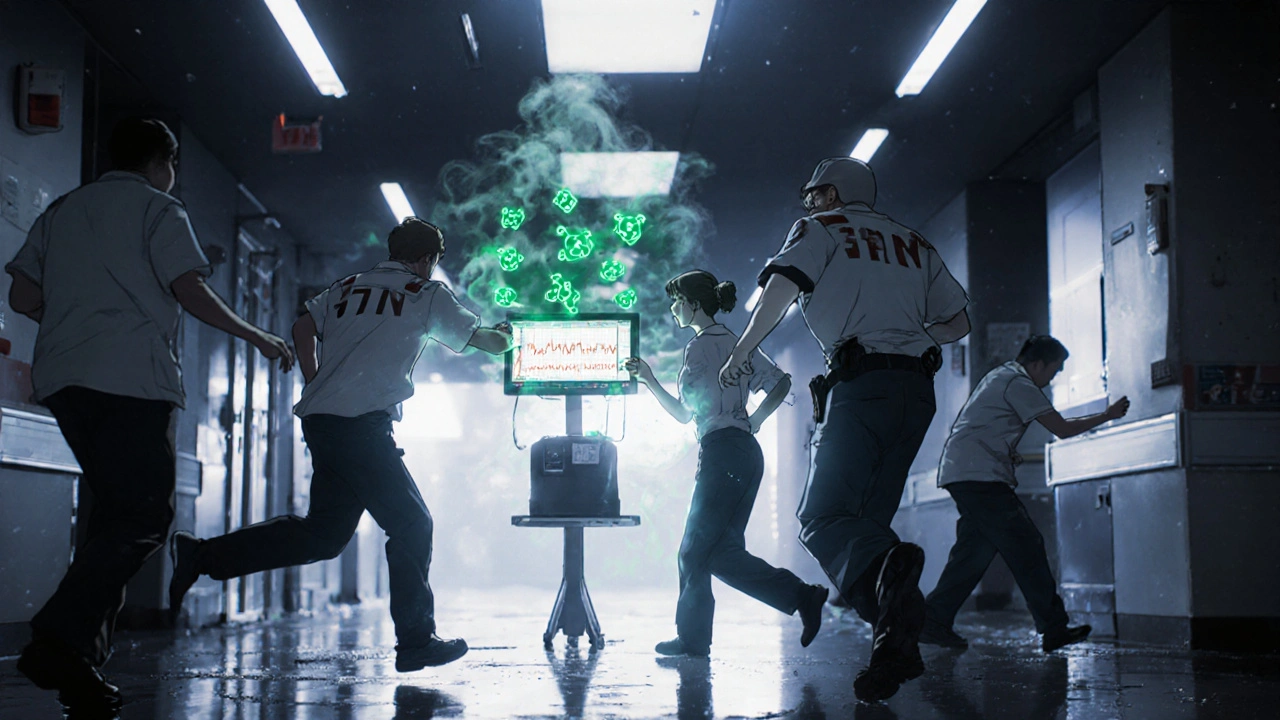
The One Tool That Saves Lives Before It’s Too Late
Doctors and nurses now agree: capnography is the most important tool for catching opioid-induced respiratory depression early.
Capnography measures carbon dioxide in your breath - end-tidal CO2. It doesn’t wait for oxygen levels to drop. It sees the problem the moment breathing becomes shallow or irregular. In a 2023 trial, capnography detected breathing problems 62 seconds before pulse oximeters showed oxygen was falling. That’s a full minute of warning.
At Johns Hopkins, 89% of critical care nurses called capnography “essential.” Yet in 2018, only 18% of U.S. hospitals used it routinely for opioid patients. By 2023, that number jumped to 68% - thanks to new Medicare and Medicaid rules that tie reimbursement to proper monitoring.
Here’s what to look for: A normal capnography waveform has a clear rise and fall with each breath. In OIRD, the waveform flattens. The pause after exhale stretches. The CO2 level rises - not because you’re producing more, but because you’re not breathing enough to get rid of it.
How to Reverse It - and When It Won’t Work
The standard protocol is the 4-2-1 rule: Start with 0.4 mg of naloxone IV. Wait two minutes. If breathing hasn’t improved, give another 0.4 mg. Repeat until the respiratory rate is above 12 breaths per minute. This works in 87% of cases - if the opioid is heroin or morphine.
But with fentanyl? You may need 2 mg, then 4 mg, then 8 mg. And you still might not get full recovery. That’s because naloxone doesn’t fix the synaptic breakdown or the prolonged expiratory pause. It only blocks the opioid from binding. If the neurons are already too quiet, they stay quiet.
That’s why some hospitals now use continuous naloxone infusions after the initial dose - especially for synthetic opioid overdoses. It keeps the opioid blocked while the body clears the drug.
There’s also a dangerous myth: “If they’re breathing, they’re fine.” Not true. A respiratory rate of 8 breaths per minute is dangerously low. Normal is 12-20. Even 10 breaths per minute with shallow breaths can lead to hypoxia in minutes.
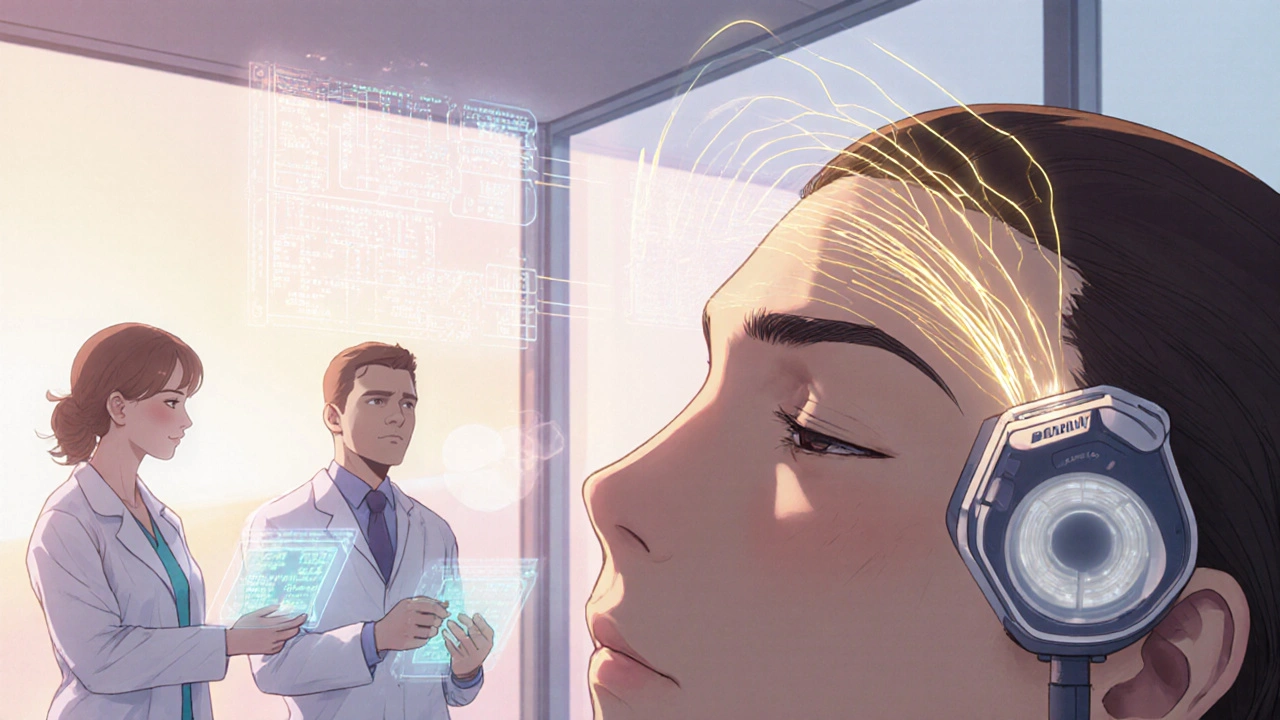
New Hope: Drugs Designed Just for Breathing
For decades, we’ve been using the same tools - naloxone, oxygen, ventilation. Now, new drugs are being developed to target the actual mechanism of OIRD.
One candidate, Brix51, activates GPR83 receptors in the parabrachial nucleus - the same area opioids silence. In trials, it restored breathing by 78% without touching pain relief. Another, TAK-861, is a “biased” opioid agonist: it relieves pain but barely affects breathing. In primates, it gave 94% pain control with only 13% respiratory depression.
In March 2024, the FDA approved the first OIRD biosensor: the RespiRhythm Monitor. It doesn’t measure breath or oxygen. It detects electrical changes in the brainstem through the skin - predicting respiratory depression 83 seconds before it happens. It’s not in every ER yet. But it’s coming.
The NIH has poured $147 million into this research since 2023. Why? Because naloxone alone won’t stop the tide. Fentanyl analogs are getting stronger. Carfentanil is already in the supply. We need tools that don’t just reverse - but prevent.
What You Need to Know Right Now
If you or someone you know uses opioids - even prescribed - here’s what matters:
- Never use alone. Someone needs to be there to call for help.
- Keep naloxone on hand. If you’re prescribed opioids, ask your doctor for a prescription for naloxone. It’s not just for addicts - it’s for anyone on pain meds.
- Know the signs: slow breathing (under 12 breaths/min), shallow breaths, blue lips, unresponsiveness.
- Call 911 even if naloxone works. The opioid can come back.
- If you’re in a hospital or clinic, ask: “Are you using capnography?” If they say no, push for it.
The opioid crisis isn’t just about addiction. It’s about a silent, invisible killer - a broken breathing rhythm that doesn’t show up on a face, until it’s too late. We now know exactly where it happens. We’re starting to fix it. But until then, awareness, monitoring, and naloxone are the only things standing between someone and death.

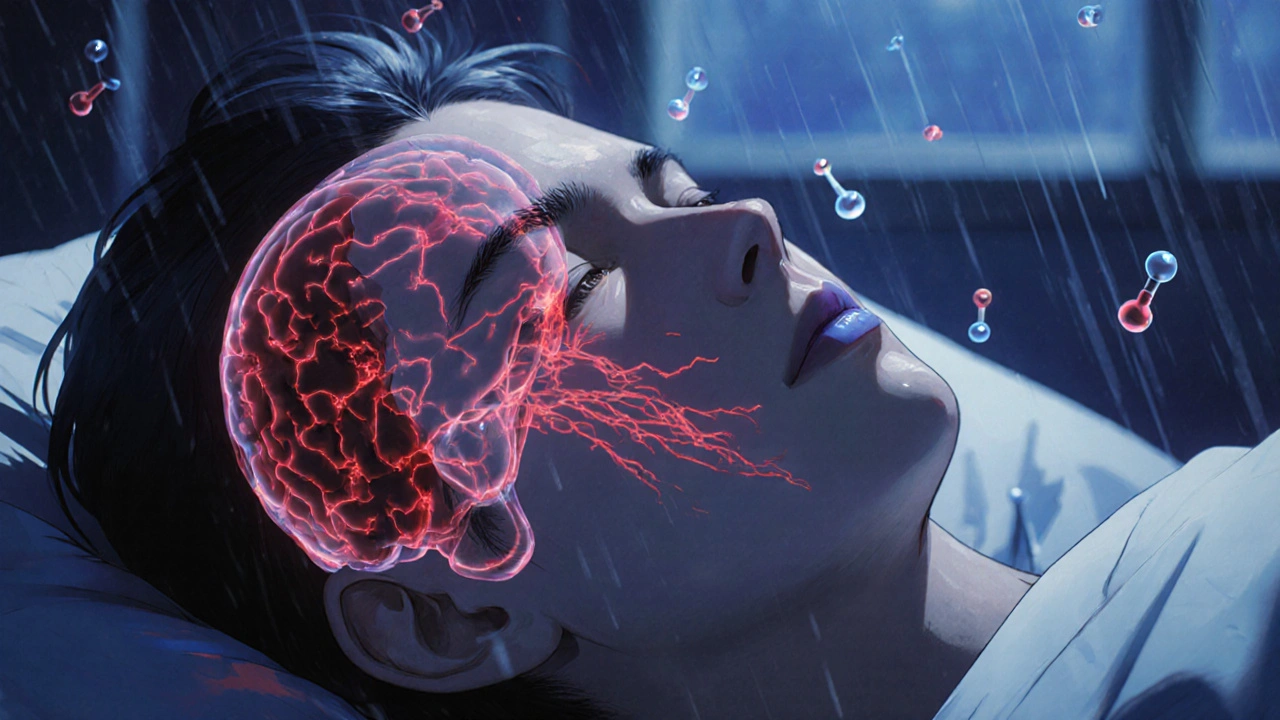


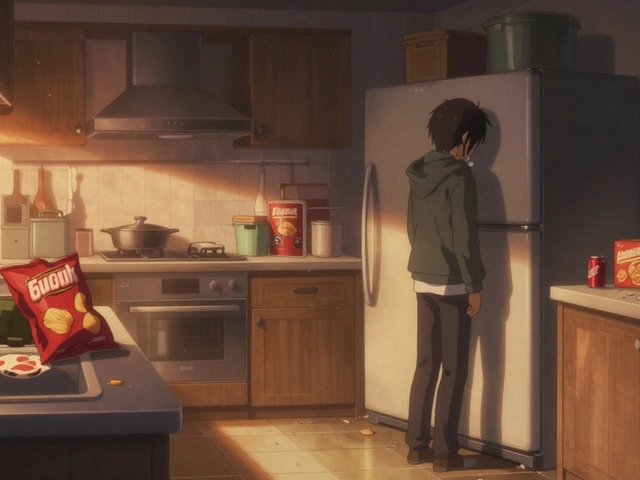
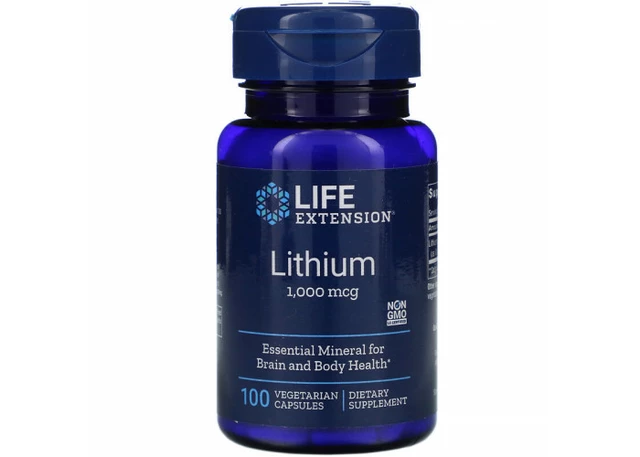
Reviews
Why are we wasting money on fancy sensors when all we need is more cops and less drugs? This whole thing is just a liberal excuse to fund hospitals while letting addicts die on the street. If you can't control your habit, you shouldn't get a second chance
Capnography? Really? Next they'll tell us the government's secretly using fentanyl to depopulate the poor. You know why they don't want you to know this? Because if people realized how easily breathing can be shut down by a chemical, they'd start asking who controls the supply chain. And that's the real crisis
Let me just say this with the precision of a neuroscientist who's read every paper since 2018: the entire opioid narrative is a pathetic misrepresentation of neural plasticity. Naloxone isn't a fix-it's a bandage on a severed spinal cord. The preBötzinger complex isn't just 'slowed'-it's been epigenetically silenced by chronic exposure. We're not treating overdoses. We're performing CPR on a corpse that's been dead for weeks. And yet we still call it 'recovery' like it's a TED Talk
Wow. A 68% adoption rate for capnography. That’s practically utopian. In my ER, we still use the ‘stare at the chest and hope’ method. I’d love to know which hospital you’re referring to-because I’m pretty sure it’s the same one that also serves free kale smoothies to patients on methadone
They're spending $147 million on biosensors but can't lock up the Chinese labs making carfentanil? This isn't science-it's surrender. We need border walls, not brainwave monitors. If you're dumb enough to snort elephant tranquilizer, you deserve what you get. Save the money for more prisons, not more gadgets
I come from a town where half the kids got hooked after a soccer injury and a prescription. I've buried friends who never touched heroin but died from a pill they thought was just pain relief. This article doesn't feel like science-it feels like a love letter to the people who didn't get to say goodbye. Capnography isn't a luxury. It's the bare minimum. We're not talking about addicts. We're talking about brothers, sisters, teachers, coaches. The system failed them before the drug ever touched their lips. We need to stop blaming the person and start fixing the machine
This is so important!! 💔 I’ve seen it happen to my cousin-woke up after naloxone, thought she was fine, then collapsed 45 mins later… 😫 We need to spread this info everywhere!! 🙏 #OpioidAwareness #CapnographySavesLives
One must observe with intellectual rigor that the temporal disparity between naloxone’s pharmacokinetic half-life and that of synthetic opioids represents not merely a clinical oversight, but a systemic failure in pharmacological design. The current paradigm assumes reversibility as binary, whereas neurophysiological suppression is, in fact, a graded, time-dependent phenomenon. One might reasonably posit that the continued reliance on naloxone as a panacea reflects a deeper epistemological flaw in our public health model
I'm just a regular guy. My neighbor took pain pills after back surgery. One day he just… stopped breathing. We didn't know what to do. Got the naloxone kit, used it. He woke up crying. Then he left the hospital because he was too sick from withdrawal. I didn't know any of this stuff. Everyone should know this. Simple. No fancy words. Just save lives
Wait so you're telling me the brain's breathing rhythm generator is like a broken metronome and naloxone just slaps the drummer but doesn't fix the broken gear? That's actually kind of beautiful in a horrifying way. Also, typo: 'parabrachial' has two 'a's, not one. Just saying. 😅 And yes, I've read the 2023 Johns Hopkins paper. The waveform flattening looks like a dying heartbeat on an EKG. Chilling.
Thank you for writing this. Honestly. I work in a clinic and we just got capnography last month. It’s changed everything. I’ve seen people who looked fine, but the monitor showed CO2 rising-so we kept them. One guy came back 2 hours later because he didn’t believe us. He was right. He needed another dose. This isn’t just tech. It’s respect. For the person. For the process. For the science. Please keep sharing this.
Who funds these ‘new drugs’? Big Pharma, of course. They’re just trying to patent a new version of the same poison. The real solution? Ban all opioids. Period. The ‘biased agonists’? A marketing ploy. They’ll just replace one addiction with another. And capnography? It’s a surveillance tool disguised as healthcare. You think they’re not tracking your breathing data? Wake up.
As a nurse in Mumbai, I see this daily. People think opioids are only for Americans. No. My patient, 68-year-old man, took painkillers for arthritis. One day, his wife found him blue. We gave naloxone. He woke up. But we had no capnography. He came back three days later with same problem. This is global. We need cheap, simple tools. Not just fancy sensors. Train community health workers. Give naloxone to families. No stigma. Just care.
Just want to say: if you’re reading this and you’re scared you might overdose, you’re not alone. You’re not a bad person. You’re someone who needs help. Keep naloxone in your bag. Tell someone you trust. You matter. This article isn’t just facts-it’s a lifeline. Thank you for writing it. And if you’re a provider? Please, please use capnography. It’s not optional. It’s love in action.